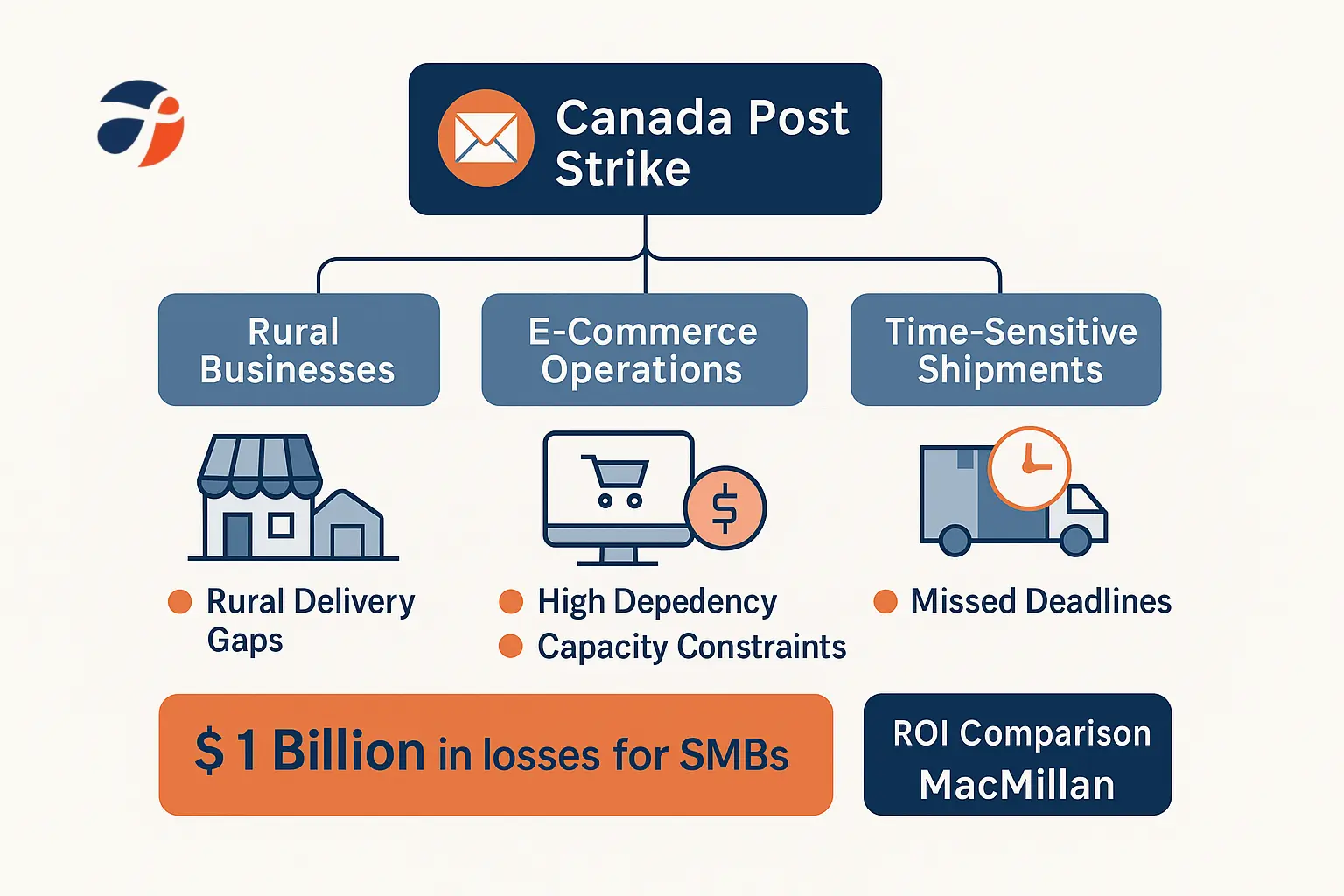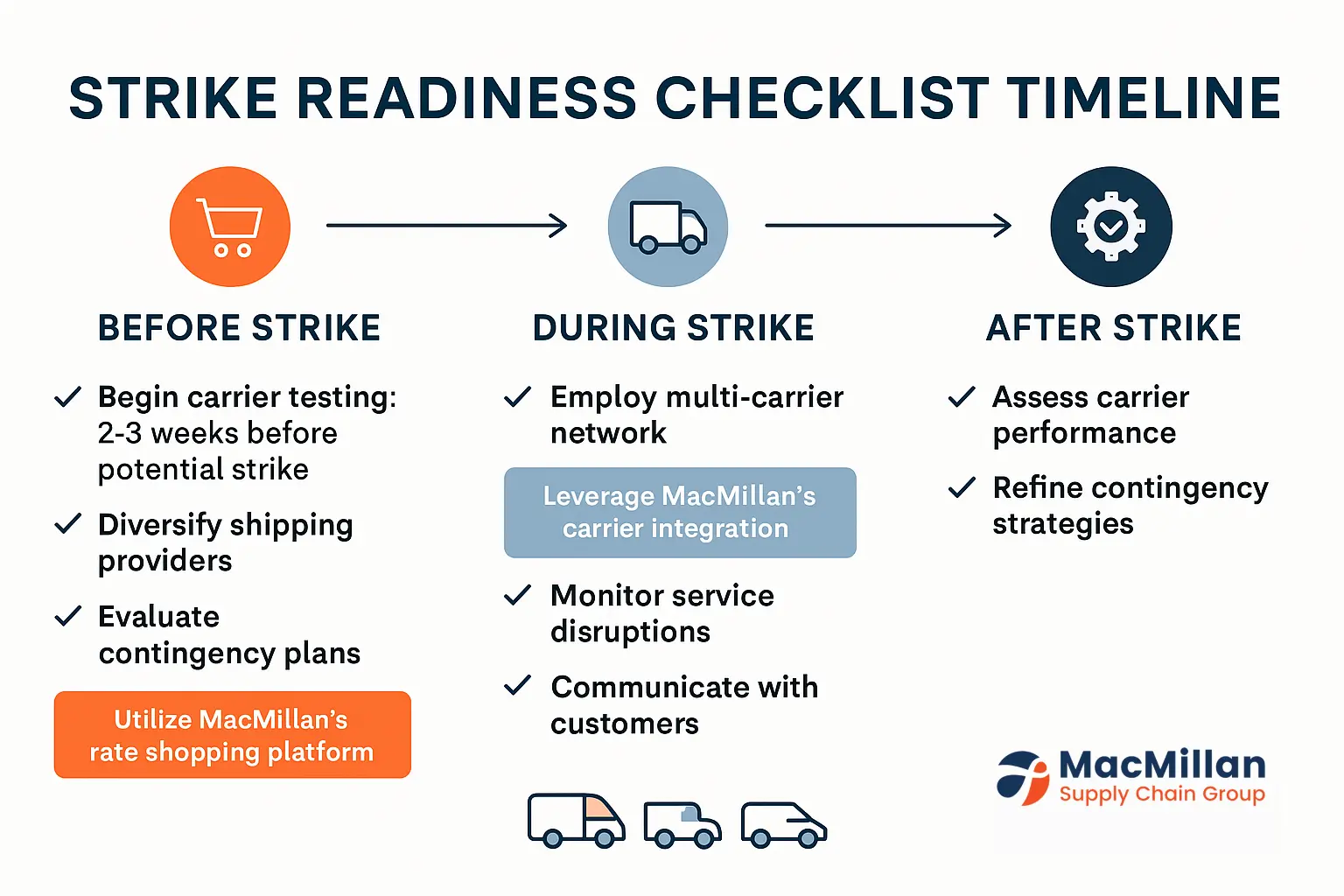Businesses across Canada are facing major shipping disruptions due to the possible impending Canada Post strike 2025. Mail service across the country could be suspended if Canada Post and the Canadian Union of Postal Workers (CUPW) don’t reach a labor agreement by May 22. This thorough manual examines the existing state of affairs, possible effects on deliveries in both urban and rural areas, and workable business solutions. We offer doable solutions to reduce interruption, ranging from inventory buffering strategies to multi-carrier strategies with substitute providers like Purolator and GoBolt. Find out how MacMillan Supply Chain Group can safeguard your company’s operations in the event of postal service outages.
The possibility of a Canada Post strike has many Canadian businesses concerned about continuity in their shipping operations.Businesses must get ready for possible postal service interruptions that could affect deliveries across the country as the May 22 deadline for talks between Canada Post and the Canadian Union of Postal Workers draws near.
A strike could result in delayed deliveries, disgruntled customers, and large revenue losses for companies that depend on prompt shipping, particularly those that serve rural areas or oversee e-commerce operations. Small and medium-sized businesses lost an estimated $1 billion in sales and incurred additional costs as a result of the most recent significant postal disruption.
We’ll take you through the current labor negotiations in this guide, explain why it’s important for your company, and offer doable tactics to reduce any disruption in the event of a Canada Post strike. If you plan ahead, your company can overcome this obstacle.
Understanding the Current Canada Post Labor Dispute
The core of the ongoing conflict between CUPW and Canada Post revolves around a number of important issues that, if not settled by May 22, could lead to a strike. What specifically is the point of contention between postal employees and management?
One of the main points of contention is weekend staffing models. While the union demands full-time positions to guarantee service reliability and improved worker benefits, Canada Post management wants to use part-time workers for weekend deliveries in order to control costs. This fundamentally different approach to workforce structure has led to a great deal of conflict.
Another crucial issue is the distribution of workload. In addition to opposing mandatory overtime, the union wants better protections for rural delivery routes, which account for about 40% of Canada Post’s traffic. Rural carriers frequently encounter particular difficulties, such as longer routes and more challenging delivery circumstances.
These negotiations have been mediated by the Industrial Inquiry Commission (IIC), which is expected to release its recommendations by May 15. Experts contend that a resolution prior to the deadline is still improbable, which raises the likelihood of a work stoppage.
Knowing these labor negotiations puts the possible disruption in perspective for companies that ship goods. The conflict goes beyond pay; it also raises important issues regarding the proper functioning of Canada’s postal service, specifically how to balance the demands of delivery in rural and urban areas.
 Impact Assessment: How a Strike Would Affect Different Businesses
Impact Assessment: How a Strike Would Affect Different Businesses
Depending on your business model, location, and clientele, a Canada Post strike would cause different degrees of disruption. Prioritizing your contingency planning is made easier when you are aware of these possible effects.
Rural Business Challenges
When postal service is interrupted, rural communities suffer the most. For necessities like government communications and medical supplies, these regions rely significantly on Canada Post. Rural businesses and customers frequently have few backup options because of the high last-mile delivery costs, which limit their options for alternative carriers. This is your biggest weakness if you cater to rural markets.
E-Commerce Operations
A strike poses a threat to the entire fulfillment process for online retailers. Many small and
medium-sized e-commerce companies reported sharp drops in sales during previous postal
disruptions as customers were hesitant to place orders because they were unsure about
shipping. Furthermore, during previous strikes, private carriers like FedEx and Purolator rapidly
reached capacity, frequently limiting new customers and giving priority to their enterprise
accounts.
Time-Sensitive Shipments
Businesses dealing with time-sensitive documents or perishable goods face particular
challenges. Legal firms, financial services, and food producers may need to completely overhaul
their distribution strategies during a strike. In these cases, having established relationships with
alternative carriers becomes not just helpful but essential for business continuity.
Identifying your specific vulnerabilities now allows for more targeted preparation before any
disruption occurs.
Alternative Carrier Solutions During Postal Disruptions
Diversifying your shipping options becomes essential when dealing with possible Canada Post
strike effects. A number of different carriers, each with unique benefits and drawbacks, can
support your delivery operations.
Key Alternative Carriers
Purolator shipping is a great substitute for Canada Post because it provides wide coverage
in both urban and rural areas. Being a Canada Post subsidiary, it continues to operate even
during strikes, though it might impose volume restrictions when demand is particularly high.
They are appropriate for companies shipping across the country due to their well-established
infrastructure.
With robust regional networks, TForce offers specialized e-commerce solutions. Their e-
commerce knowledge makes them useful for online retailers, even though their prices might be
higher for large shipments.
UPS and FedEx provide worldwide network integration, but when capacity is limited, they
usually give priority to their enterprise clients. These carriers are most effective for companies
that ship internationally and have existing accounts.
Implementing a Multi-Carrier Strategy
Rather than relying on a single alternative, consider a multi-carrier approach that combines
different providers based on delivery location, package size, and urgency. This approach
optimizes expenses and reduces single-point failures. This strategy can be made more
manageable by using third-party logistics platforms to simplify carrier rate comparison and integration.
A proactive approach to business preparation
Your company has the best chance of minimizing disruption if you act before a Canada Post
strike happens. As part of your strike contingency plan, you can put these doable actions into
action right now.
Expand Your Carrier Connections
As soon as possible, start assigning 30–40% of your shipping volume to non-Canada Post
carriers. This achieves two important goals: it enables you to test the quality and dependability
of their services and helps you build relationships with alternative providers before they reach
capacity. Pay attention to carriers that fit your unique shipping profile and clientele’s locations.
Strategic Inventory Management
A strong defense against shipment delays is inventory buffering. Think about temporarily raising
your inventory levels, especially for your best-selling items. To lessen reliance on long-distance
shipping, try to spread inventory among several warehouses in various locations. This strategy
is particularly beneficial for companies with steady sales trends.
Open Communication with Customers
In times of uncertainty, proactive customer communication fosters trust. Create messaging
outlining your mitigation strategies and explaining any delays that may occur. Think about
providing flexible delivery options or upgraded expedited shipping. Customers are more likely to
stay patient and devoted when they comprehend the situation and witness your prompt action.
Preparing Financially
Allow for a 20–30% increase in shipping costs during a strike. If you suddenly need to switch to
more costly shipping options, having financial contingencies in place helps you avoid cash flow
issues. Think about allocating money expressly to deal with strike-related issues.
Typical Obstacles During Postal Interruptions
Businesses encounter a number of enduring issues during a Canada Post strike, despite
meticulous preparation. Gaining an understanding of these difficulties enables you to create
more successful countermeasures.
Capacity Limitations with Other Carriers
Many carriers rapidly reach capacity limits when thousands of businesses look for alternate
shipping options at the same time. As a result, new clients may be completely turned away, and
even long-term clients may experience delays. Within 48 hours of the announcement of the
strike during the most recent significant postal disruption, some alternative carriers ceased to
accept new accounts.
Rural Delivery Gaps
There are major delivery challenges in rural areas because many private carriers have limited
coverage in these areas. Complete delivery halts for non-essential items may occur in areas
that rely significantly on Canada Post. Businesses that cater to small towns, rural areas, and
agricultural communities are especially affected by this.
Problems with Cost Predictability
During strikes, shipping prices frequently become extremely volatile. Some carriers use
premium pricing or emergency surcharges when demand spikes. Budgeting is challenging
because of this unpredictability, which can also reduce profit margins, particularly for companies
with narrow margins.
Cross-Border Complications
During postal disruptions, international shipments encounter additional challenges. Depending
on the carrier, cross-border tariffs may apply differently, documentation requirements may
change, and customs clearance may take longer. For companies with sizable clientele in the US
or abroad, this poses unique difficulties.
Managing Customer Perception
Customers frequently blame the merchant for delivery issues, even when you are not at fault. It
takes extraordinary communication and problem-solving abilities to keep up good customer
relations during service interruptions.
# Our solutions (400 words)
MacMillan Supply Chain’s Comprehensive Strike Mitigation Solutions
We at MacMillan Supply Chain Group have created strong plans to assist companies in
successfully navigating postal service interruptions. Our solutions offer flexibility to adjust to
your unique business needs while addressing the fundamental difficulties of a Canada Post
strike.
Access to Multi-Carrier Networks
Our long-standing connections with a variety of carriers provide your company with instant
access to shipping options without the hassle of opening new accounts in an emergency. We
have strategic alliances with:
National carriers such as Purolator, UPS, and FedEx for extensive coverage;
Regional specialists such as GoBolt logistics for urban markets and specialized rural carriers;
Last-mile delivery experts who can reach customers in difficult-to-reach places
Even during times of high demand, we are able to secure preferential rates and capacity
guarantees thanks to our consolidated volume approach. This implies that while some
shipments experience delays and rejections, yours keeps on moving.
Dynamic Routing Optimization
For every shipment, our in-house technology automatically chooses the best carrier based on:
Urban versus rural destination; package attributes (size, weight, and value); and the urgency of
delivery
Present carrier performance and capacity
During a strike, this clever routing system adapts in real-time to changing conditions,
guaranteeing that your deliveries take the most dependable route possible. Complete visibility is
also made possible by the system’s unified tracking across all carriers.
Distributed Inventory Solutions
Through our network of warehouses across Canada, we provide strategic inventory buffering.
We lessen reliance on long-distance shipping during disruptions by putting your products closer
to end users. Our system for managing inventory offers:
Real-time stock visibility in every location
Automated restocking according to local demand trends
Seasonal or promotional items can be stored in a variety of ways.
Even in situations where primary shipping channels are not available, this distributed approach
greatly decreases delivery times and improves fulfillment reliability.
Cross-Border Continuity Planning
We offer customized cross-border solutions that avoid possible Canada Post disruptions for
companies with U.S. clients or suppliers:
Direct injection through alternate entry points into the USPS network
To maximize customs clearance, cross-border shipping was consolidated.
Knowledge of documentation to avoid border delays
Strategies for Financial Protection
Financial protections that lessen the effects of shipping cost increases during strikes are
advantageous to our clients:
Our carrier agreements include protections against surge pricing and rate caps.
– Clear cost reporting to assist in managing budgets during disruptions – Volume-based
discounts that are applicable throughout our whole carrier network
By combining these solutions, MacMillan Supply Chain creates a resilient shipping ecosystem
that continues functioning effectively even when Canada Post services are unavailable.
 Acting: Putting Your Strike Readiness Plan Into Practice
Acting: Putting Your Strike Readiness Plan Into Practice
To safeguard your company, don’t wait for a Canada Post strike to be declared. Here’s how to put an efficient backup plan into action right now:
Steps You Can Take Right Away
To find out how reliant on Canada Post you are, first check your shipping profile. Determine
which shipment types and destinations are the most vulnerable.
2. Start experimenting with other carriers using some of your shipments. This allows you to
gain hands-on experience with various providers prior to a crisis.
3. To maintain service levels during disruptions, review your inventory strategy and see if
you require additional stock buffers or regional distribution points.
4. Get customer communications ready that outline your backup plans and establish
reasonable expectations for any delays.
Collaborate with MacMillan Supply Chain for Total Security
Although these actions offer a solid starting point, working with MacMillan Supply Chain Group
offers complete protection against interruptions in the postal service. Our staff offers decades of
logistics experience that is especially suited to the Canadian market, including in-depth
understanding of the difficulties associated with rural delivery and peak season readiness.
To create your unique strike contingency plan, get in touch with MacMillan Supply Chain right
now. Our logistics specialists will evaluate your particular needs and create a strong shipping
strategy to ensure business continuity, regardless of Canada Post’s operational status.
Avoid allowing disagreements among postal workers to interfere with your company
operations and clientele. You can handle any shipping issue with assurance and dependability if
MacMillan Supply Chain is your logistics partner.
To arrange a consultation, contact us by phone at 416-941-2759
Follow us on LinkedIn for real-time tariff updates
Frequently Asked Questions About Canada Post Strike Preparedness
The current deadline for labor negotiations is May 22. If Canada Post and the Canadian Union
of Postal Workers don't reach an agreement by then, a strike or lockout could begin
immediately. The Industrial Inquiry Commission will publish recommendations by May 15, which
may influence negotiations, but experts consider a work stoppage increasingly likely.
E-commerce companies, subscription box services, and businesses serving rural communities
face the greatest risks. Companies that rely heavily on Canada Post for shipping lightweight
parcels or that lack established relationships with alternative carriers will experience the most
significant disruptions. Small businesses typically have fewer resources to implement
comprehensive contingency plans.
Historical data shows that Canada Post labor disputes have lasted anywhere from a few days to
several weeks. The 2018 strike lasted 37 days before being ended by back-to-work legislation.
Businesses should prepare for a minimum two-week disruption, with contingency plans that can
extend to 30-45 days if necessary.
Most regular mail and parcel services would cease during a full strike. However, certain
essential services might continue on a limited basis, such as government pension checks and
some social assistance payments. All commercial shipping would likely be completely suspended.
During normal operations, setting up new carrier accounts typically takes 3-7 business days.
However, during a strike, this process can extend to 2-3 weeks as carriers face application
backlogs. Working with a 3PL like MacMillan Supply Chain provides immediate access to
multiple carriers without this delay.
Transparency builds trust. Inform customers about the situation, your contingency plans, and
potential delays. Offer realistic delivery timeframes rather than promising unachievable speeds.
Consider providing shipping upgrades or special promotions to maintain goodwill during
disruptions.
Prepare for shipping cost increases of 20-30% during a Canada Post strike. This accounts for
both higher base rates from alternative carriers and potential surge pricing during peak demand.
Smaller packages and rural deliveries typically see the largest percentage increases.
For some businesses near the border, shipping through U.S. carriers and USPS may provide an
alternative. However, this approach involves cross-border documentation, potential delays at
customs, and additional handling. It works best for higher-value items where the additional cost can be justified.
Develop a flexible returns policy that accounts for carrier limitations. Consider extending return
windows, offering multiple return methods, or implementing temporary local drop-off points.
Clearly communicate these options to customers to reduce confusion and support requests.
Implement a permanent multi-carrier strategy rather than relying exclusively on Canada Post.
Develop relationships with regional carriers, invest in transportation management systems that
support carrier diversification, and consider distributed inventory models that reduce shipping distances.

 Impact Assessment: How a Strike Would Affect Different Businesses
Impact Assessment: How a Strike Would Affect Different Businesses Acting: Putting Your Strike Readiness Plan Into Practice
Acting: Putting Your Strike Readiness Plan Into Practice